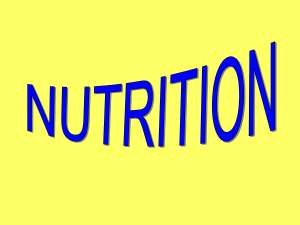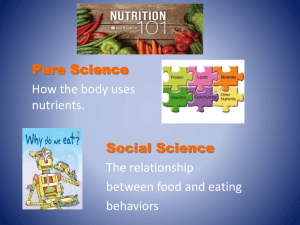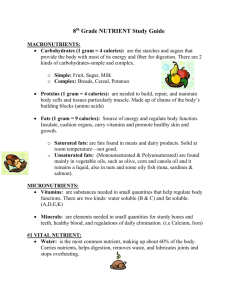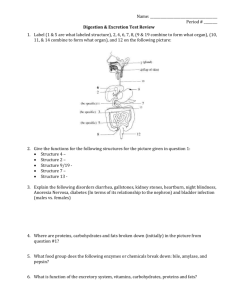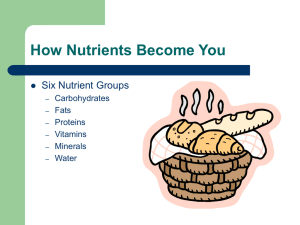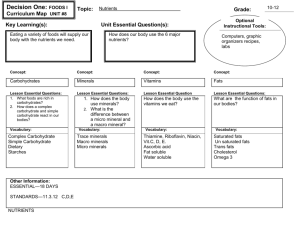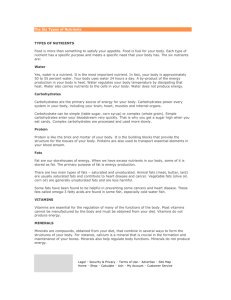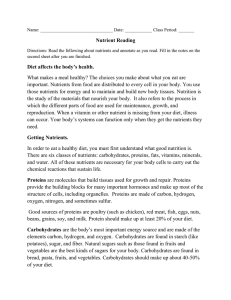How Nutrients Become You
advertisement
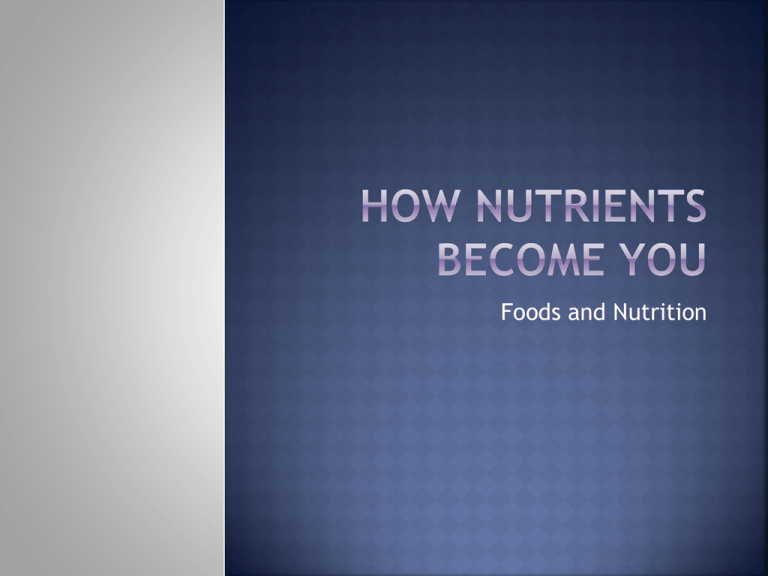
Foods and Nutrition THE SIX NUTRIENT GROUPS Carbohydrates Fats Proteins Vitamins Minerals Water Elements – simplest substance from which all matter is formed Matter – anything that takes up space and has a measurable quantity Atom – smallest part of an element Molecule – smallest amount of a substance that has all the characteristics of the substance Compound molecule – atoms of different elements bonded together Carbohydrates, fats, proteins, vitamins, and water are compounds Hydrogen, oxygen, nitrogen, sulfur, and cobalt common, least 25 chemical elements needed Minerals are elements Build and repair body tissues Body continues to produce new cells until death Need more during prenatal period, infancy, adolescence Replace old cells Repair damaged cells Regulate body processes Chemical reactions in body use nutrients pH balance in blood, digestion, circulation of body fluids, metabolism Provide energy Quality of food affects energy level Necessary for all life processes (breathe, pump blood, muscles move, body heat Carbohydrates and fats main energy source Protein other source of energy Kilocalories - amount of heat needed to raise one kilogram of water one degree Celsius Also called calories 1 gram of carbohydrates = 4 kilocalories of energy 1 gram of fats = 9 kilocalories of energy 1 gram of proteins = 4 kilocalories of energy Water, vitamin, minerals have no energy value therefore no calories Alcohol provides 7 calories per gram Not a nutrient because it does not promote growth: it’s a drug Digestion- process by which your body breaks down food, and nutrients on food into simpler substances Mechanical digestion – happens as food is crushed and churned Chemical digestion – food is mixed w/ acids and enzymes Enzymes- protein produced by cells that cause a specific chemical reactions Gastrointestinal (GI)tract – muscular tube leading from the mouth to the anus Absorption – passage of nutrient from the digestive tract into the circulatory or lymphatic system Most absorption happens in small intestines Covered with villi – tiny, fingerlike projections that give velvety texture Water-soluble Dissolve in water (capillaries absorb most water) Fat-soluble nutrients nutrients Dissolve in fat (lacteals absorb fat) Absorption completed in large intestines All the chemical changes that occur as cells produce energy and material needed to sustain life Cells use compounds for energy or store to replace cells Stores energy as adenosine triphosphate (ATP) Waste removed through urinary system Eating habits What you eat and how you eat Need fiber Emotions Fear, anger, and tension can lead to digestive problems Reduce stress Food Allergies Reaction to the immune system to a certain proteins found in food. Food sensitivity – reactions to food that do not involve the production of antibodies by the immune system Physical activity Helps with digestion and metabolism Strengthen muscles in internal organs What is it? Diarrhea Constipation Indigestion Heartburn Ulcer Gallstones Diverticulitis Treatments
